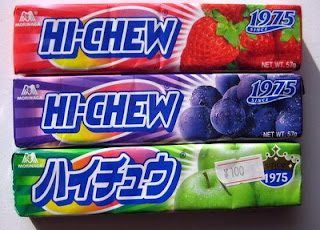Snack on This: TTAB Sustains 2(d) Opposition to MYCHEW over HI-CHEW for Candy
The Board didn't waste much time on the substantive issues in sustaining a Section 2(d) opposition to registration of the mark MYCHEW in the stylized form shown below, for candy, finding it likely to cause confusion with the registered mark HI-CHEW in stylized form, also for candy. The Board recognized that "chew" is a weak formative for candy, but it concluded that the marks as a whole are substantially similar.Various procedural issues took up the first half of the 20-page decision. Morinaga & Co., Ltd. v. Crown Confectionary, Co., Ltd., Opposition No. 91171726 (February 17, 2011) [not precedential].

"International Comity": Applicant asserted in its answer that "international comity" required the Board to recognize certain foreign registrability decisions favoring Applicant over Opposer. It also asserted that U.S. membership in the World Trade Organization bars the opposition because the U.S. is prohibited from giving "local preferences."
Applicant did not pursue these affirmative defenses, but the Board proceeded to chew them apart anyway. First, foreign decisions regarding trademark registrability have no effect in the U.S. [Doh! - ed.]. The WTO defense was equally useless: the Board pointed out that the "trademark registration opposition system in the United States provides equal treatment for all opposers and applicants, regardless of their national origin or status in the United States." [Cue the marching band! - ed.]
Third-party registrations: The Board sustained Opposer's objection to Applicant's submission of a list of third-party registrations and applications. A mere list is not a proper way to submit registrations. Moreover, cancelled registrations prove nothing, nor do pending applications.
Applicant did properly submit several third-party registrations, but they are not evidence that the marks are in use, nor are they proof that consumers are familiar with the marks. They may, however, show that a particular word has a readily understood meaning and that it has been adopted by third parties to express that meaning.

Page Limitation Violation?: Opposer claimed that Applicant's trial brief exceeded the applicable page limitation [55 pages, including table of contents, index of cases, description of the record, statement of the issues, recitation of the facts, argument, and summary. See Rule 2.128(b).]
Applicant's brief comprised 49 pages, including table of contents and authorities, but not including the cover pages or certificate of service. It also had a 7-page appendix. The main text was double-spaced in 11-point type (ok under Rule 2.126(b)), but its 53 single-spaced footnotes and six pages of tables were in 10-point type.
The Board noted that footnotes may not be used "as a subterfuge to avoid the page limit." Exhibits or appendices are not part of the brief and do not count toward the page limit. Evidentiary objections may be raised in an appendix (or by a separate statement of objections).
The Board found Applicant's brief to be within the page limitations. The footnotes include arguments that "could have been made in the body of the brief, although we are not troubled by their single-spacing, as this is usual in most briefs." However the Board found that, on balance, the brief was acceptable in length and the Board considered the entire brief. [Wasn't it all or nothing? - ed.] The appendix properly contained evidentiary objections. [The ten-point type was not specifically mentioned - ed.]
Objections to Testimony: Opposer objected to nearly all of Applicant's questions, but failed to renew its objections in its trial brief. Opposer did state in its reply that it maintained all the objections, but that was too, said the Board, and not specific enough. A blanket statement that all objections are renewed does not cut the mustard.
TTABlog comment: Take a look at Applicant's brief (here) and see if you agree with the Board's ruling on the page limitations question.
Text Copyright John L. Welch 2011.

1 Comments:
This is one of those decisions that seem to fall in the category "the marks are similar because I say so," no matter how much case law they cite. I am hard pressed to think that anyone would confuse those two design marks. But then, this is what I say ...
Post a Comment
<< Home